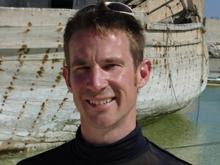My name is Steve Simpson and I am a marine biologist in the School of Biological Sciences. My focus for some time has been on how global environmental change influences fish, fisheries and marine ecosystems. At the moment my work in Bristol focuses on the effects of warming on European fisheries and the impacts of anthropogenic noise on marine ecosystems. The first two months of my NERC/Cabot Knowledge Exchange fellowship, which builds on these themes, has presented some fantastic opportunities to explore how my research, and that of all my collaborators in Bristol and beyond, can feed into UK policy and industry.
I was lucky that our study on the effects of warming over the last 30 years on the European fish assemblage came out just as I was starting. This meant I was able to spend a day with the Guardian at Brixham fishing port in Devon talking to trawlermen, wholesalers, fishmongers and restaurateurs about how their catches have been changing. After 3 years of staring at records of over 100 million fish on a computer screen, it was great to hear that their experiences matched up with our analysis. This experience was quickly followed by a week with the International Council for the Exploration of the Seas (ICES) assimilating all the current evidence on influences of climate change on fisheries. I am now developing ideas for a documentary that looks at the science behind changing fisheries and showcases some of the exciting fish we will be eating in abundance in the future. Get ready for John dory and chips…
The week I started my fellowship I was at a meeting at UNESCO in Paris, making plans for an International Year of Ocean Acoustics and discussing ideas for some global experiments on effects of anthropogenic noise in the marine environment. The seas have become much more noisy in the past few decades, due to shipping, oil/gas extraction, windfarm construction and naval activities, and we have to get it right in terms of managing noise without unnecessarily hampering marine industries. The issue of noise has raised some very interesting questions about the precautionary principle, mitigation vs. compensation, and extrapolating findings from small-scale experiments to population-level predictions. I have spent the past few weeks planning a workshop, to be held in Bristol in March next year, where representatives from academia, industry, policy and management will work together to plan the science needed to ensure an environmentally and economically sustainable future for UK waters.
The first 2 months have been hugely exciting and shown me how valuable the Cabot community is for encouraging thinking outside the box, drawing on experience from other groups (e.g. flood risk management informing our future fisheries predictions), and building strong links with the research-end users (aka the real world!). The NERC KE team are doing a fantastic job of building Knowledge Exchange, making the science they fund really deliver, and with Cabot and the RED team in Bristol we’ll be giving training and advice at a KE workshop in January. Watch this space…
